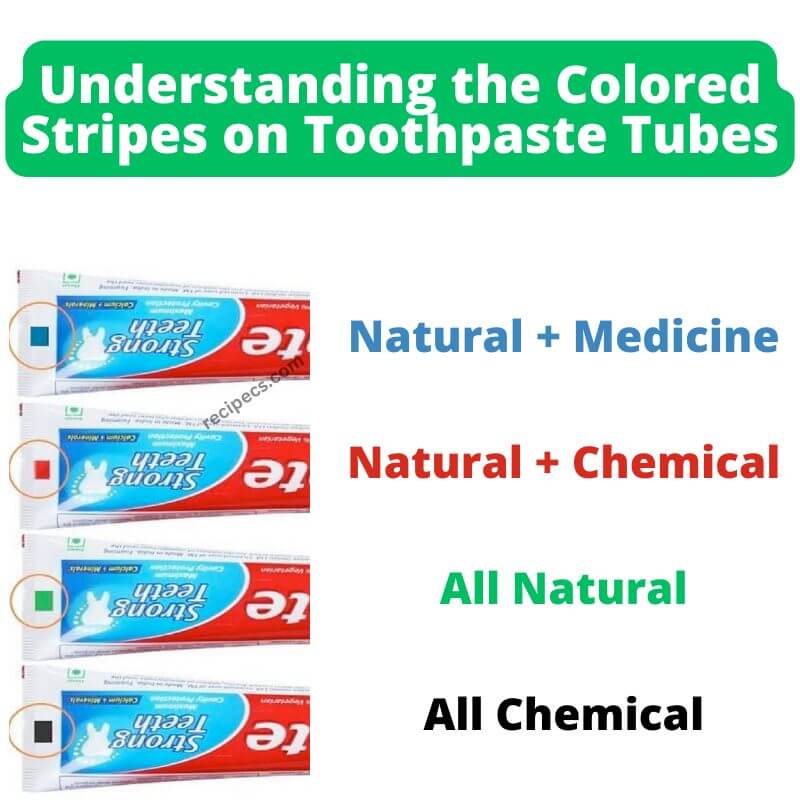Would you like to save this?
Toothpaste plays a crucial role in maintaining oral hygiene, helping to prevent tooth decay, protect against cavities, and eliminate bad breath. With a plethora of brands catering to various dental needs, choosing the right one can be overwhelming. Have you ever noticed a colored stripe on your toothpaste tube? Many people are curious about what these colors signify.
Understanding the Colored Stripes on Toothpaste Tubes
The colored stripes on toothpaste tubes are often surrounded by myths and misunderstandings. Let’s delve into the meanings behind these stripes and how they can guide you in selecting the right toothpaste.
Red Line
A red stripe on a toothpaste tube typically indicates a combination of natural and synthetic ingredients. This type of toothpaste incorporates both natural elements and artificial chemicals. While it’s important to minimize exposure to unnecessary chemicals in daily products, toothpastes with a red stripe can offer a balanced formula designed to provide comprehensive dental care.
Toothpaste with a red stripe might include ingredients like fluoride for cavity protection and other synthetic additives that enhance the cleaning power. However, these additives may raise concerns for those striving for a chemical-free lifestyle. It’s beneficial to read the ingredient list carefully to understand what each component does for your oral health.
Green Line
A green stripe signifies that the toothpaste is made entirely from natural ingredients. This means it does not contain any artificial chemicals, medications, or whitening agents. Green-striped toothpaste is ideal for individuals seeking a more organic approach to oral care, free from synthetic additives.
Natural toothpastes often include ingredients like baking soda, essential oils, and herbal extracts. These ingredients can effectively clean teeth, freshen breath, and promote overall oral health without the use of synthetic chemicals. If you prefer a more natural lifestyle, a toothpaste with a green stripe is a suitable choice.
Blue Line
Toothpaste with a blue stripe indicates a blend of natural ingredients and medicinal additives. These medicinal components could include whitening agents or pain relievers, providing additional benefits beyond basic cleaning.
For instance, toothpastes with a blue stripe might contain ingredients like hydrogen peroxide for whitening or potassium nitrate for sensitivity relief. This combination can be particularly useful for individuals looking for targeted dental solutions while still incorporating some natural elements.
Black Line
The black stripe on a toothpaste tube is often viewed with caution, as it signifies that the toothpaste is made entirely from artificial chemicals. This means that every ingredient in the toothpaste is synthetic, with no natural components.
While synthetic ingredients can be highly effective in addressing specific dental issues, such as advanced whitening or intensive plaque removal, they may also raise concerns regarding long-term use. It’s advisable to limit the use of such toothpastes and consider alternating with more natural options to reduce potential chemical exposure.
The Importance of Ingredient Awareness
Understanding the colored stripes on toothpaste tubes can be a helpful guide, but it’s essential to go beyond the color codes and examine the ingredient list. Ingredients like fluoride, triclosan, sodium lauryl sulfate, and various preservatives each serve distinct purposes but may have different health implications.
- Fluoride: Widely recognized for its cavity-preventing properties, fluoride helps strengthen enamel and prevent decay. However, excessive fluoride can lead to dental fluorosis, especially in children.
- Triclosan: An antibacterial agent that helps reduce gum disease, but its safety is debated due to potential hormone-disrupting effects.
- Sodium Lauryl Sulfate (SLS): A detergent that creates foam, aiding in the removal of debris. Some individuals may find SLS irritating to their gums and mouth.
- Preservatives and Flavorings: These keep the toothpaste stable and palatable but may include artificial chemicals that some prefer to avoid.
Making an Informed Choice
When selecting a toothpaste, consider your specific dental needs and preferences. Whether you choose a toothpaste with a green stripe for its natural ingredients, a blue stripe for its medicinal benefits, a red stripe for a balanced approach, or cautiously use a black-striped toothpaste for its potent cleaning power, being informed about what’s inside your toothpaste is crucial.
Conclusion
The colored stripes on toothpaste tubes provide a quick reference to the type of ingredients they contain, helping you make informed decisions about your oral care products. While green signifies all-natural ingredients, blue indicates a mix of natural and medicinal, red a blend of natural and synthetic, and black entirely artificial components. Understanding these codes and paying attention to ingredient lists can help you choose a toothpaste that aligns with your health goals and personal preferences. Whether you aim for natural products or need specific dental treatments, knowing what these stripes mean empowers you to make the best choice for your oral health.







